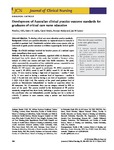Development of <scp>A</scp>ustralian clinical practice outcome standards for graduates of critical care nurse education
| dc.contributor.author | Gill, Fenella | |
| dc.contributor.author | Leslie, GD | |
| dc.contributor.author | Grech, C | |
| dc.contributor.author | Boldy, D | |
| dc.contributor.author | Latour, Jos M | |
| dc.date.accessioned | 2017-01-21T10:01:15Z | |
| dc.date.available | 2017-01-21T10:01:15Z | |
| dc.date.issued | 2015-02 | |
| dc.identifier.issn | 0962-1067 | |
| dc.identifier.issn | 1365-2702 | |
| dc.identifier.uri | http://hdl.handle.net/10026.1/8280 | |
| dc.description.abstract |
<jats:sec><jats:title>Aims and objectives</jats:title><jats:p>To develop critical care nurse education practice standards.</jats:p></jats:sec><jats:sec><jats:title>Background</jats:title><jats:p>Critical care specialist education for registered nurses in Australia is provided at graduate level. Considerable variation exists across courses with no framework to guide practice outcomes or evidence supporting the level of qualification.</jats:p></jats:sec><jats:sec><jats:title>Design</jats:title><jats:p>An eDelphi technique involved the iterative process of a national expert panel responding to three survey rounds.</jats:p></jats:sec><jats:sec><jats:title>Methods</jats:title><jats:p>For the first round, 84 statements, organised within six domains, were developed from earlier phases of the study that included a literature review, analysis of critical care courses and input from health consumers. The panel, which represented the perspectives of four stakeholder groups, responded to two rating scales: level of importance and level of practice.</jats:p></jats:sec><jats:sec><jats:title>Results</jats:title><jats:p>Of 105 experts who agreed to participate, 92 (88%) completed survey round I; 85 (92%) round <jats:styled-content style="fixed-case">II</jats:styled-content>; and 73 (86%) round <jats:styled-content style="fixed-case">III</jats:styled-content>. Of the 98 statements, 75 were rated as having a high level of importance – median 7 (<jats:styled-content style="fixed-case">IQR</jats:styled-content> 6–7); 14 were rated as having a moderate level of importance – median 6 (<jats:styled-content style="fixed-case">IQR</jats:styled-content> 5–7); and nine were rated as having a low level of importance – median 4 (<jats:styled-content style="fixed-case">IQR</jats:styled-content> 4–6)–6 (<jats:styled-content style="fixed-case">IQR</jats:styled-content> 4–6). The majority of the panel rated graduate level of practice as ‘demonstrates independently’ or ‘teaches or supervises others’ for 80 statements. For 18 statements, there was no category selected by 50% or more of the panel. The process resulted in the development of 98 practice standards, categorised into three levels, indicating a practice outcome level by the practitioner who can independently provide nursing care for a variety of critically ill patients in most contexts, using a patient‐ and family‐focused approach.</jats:p></jats:sec><jats:sec><jats:title>Conclusion/relevance to clinical practice</jats:title><jats:p>The graduate practice outcomes provide a critical care qualification definition for nursing workforce standards and can be used by course providers to achieve consistent practice outcomes.</jats:p></jats:sec> | |
| dc.format.extent | 486-499 | |
| dc.format.medium | Print-Electronic | |
| dc.language | en | |
| dc.language.iso | eng | |
| dc.publisher | Wiley | |
| dc.subject | assessment | |
| dc.subject | Delphi study | |
| dc.subject | graduate-level education | |
| dc.subject | intensive care | |
| dc.subject | nursing | |
| dc.subject | nursing education research | |
| dc.subject | postregistration qualifications | |
| dc.title | Development of <scp>A</scp>ustralian clinical practice outcome standards for graduates of critical care nurse education | |
| dc.type | journal-article | |
| dc.type | Journal Article | |
| plymouth.author-url | https://www.webofscience.com/api/gateway?GWVersion=2&SrcApp=PARTNER_APP&SrcAuth=LinksAMR&KeyUT=WOS:000350348600017&DestLinkType=FullRecord&DestApp=ALL_WOS&UsrCustomerID=11bb513d99f797142bcfeffcc58ea008 | |
| plymouth.issue | 3-4 | |
| plymouth.volume | 24 | |
| plymouth.publication-status | Published | |
| plymouth.journal | Journal of Clinical Nursing | |
| dc.identifier.doi | 10.1111/jocn.12631 | |
| plymouth.organisational-group | /Plymouth | |
| plymouth.organisational-group | /Plymouth/Faculty of Health | |
| plymouth.organisational-group | /Plymouth/Faculty of Health/School of Nursing and Midwifery | |
| plymouth.organisational-group | /Plymouth/REF 2021 Researchers by UoA | |
| plymouth.organisational-group | /Plymouth/REF 2021 Researchers by UoA/UoA03 Allied Health Professions, Dentistry, Nursing and Pharmacy | |
| plymouth.organisational-group | /Plymouth/Research Groups | |
| plymouth.organisational-group | /Plymouth/Research Groups/Institute of Health and Community | |
| plymouth.organisational-group | /Plymouth/Research Groups/Plymouth Institute of Health and Care Research (PIHR) | |
| plymouth.organisational-group | /Plymouth/Users by role | |
| plymouth.organisational-group | /Plymouth/Users by role/Academics | |
| dc.publisher.place | England | |
| dcterms.dateAccepted | 2014-03-24 | |
| dc.identifier.eissn | 1365-2702 | |
| dc.rights.embargoperiod | Not known | |
| rioxxterms.versionofrecord | 10.1111/jocn.12631 | |
| rioxxterms.licenseref.uri | http://www.rioxx.net/licenses/all-rights-reserved | |
| rioxxterms.licenseref.startdate | 2015-02 | |
| rioxxterms.type | Journal Article/Review |


